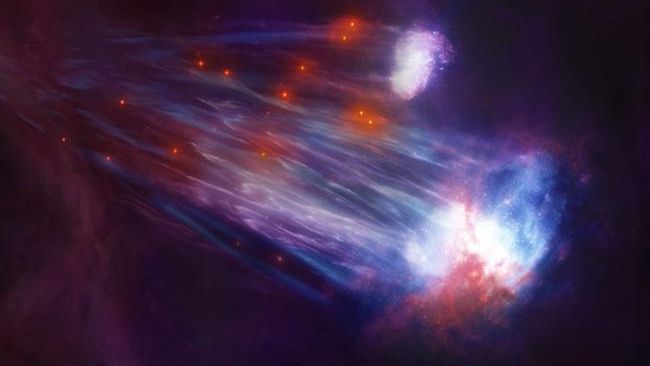A mysterious river of gas flowing into the Milky Way has stars inside after all
By Tereza Pultarova published about 13 hours ago
A river of gas emanating from two tiny galaxies in the Milky Way's outskirts hosts stars after all.

two cosmic jellyfish-looking gaseous wisps, one larger than the other in the foreground, have red shining dots along some of their tentacles as they fly through the black of space.
(Image credit: CfA / Melissa Weiss)
A river of hydrogen gas flows outward from the Large and Small Magellanic Clouds, two dwarf galaxies located in the outskirts of the Milky Way. The contents of this river, called the Magellanic Stream, has puzzled astronomers for decades. But now, for the first time, a team of researchers has been able to locate stars within the stream's gaseous clouds. The discovery will not only help them better understand the evolution of the stream's home galaxies, but also the distribution of matter in the Milky Way itself.
The astronomers, from the Harvard–Smithsonian Center for Astrophysics, found the stars using the 21-foot (6.5 meters) Magellan Baade Telescope at Las Campanas Observatory in Chile. With the help of a detailed Milky Way map, created by the European Space Agency's Gaia space telescope, the researchers zeroed-in on 200 stars sitting in the farthest reaches of our galaxy, located in the direction of the Magellanic Stream.
They analyzed the spectrum of light emanating from those stars and found that the chemical composition of 13 subjects matched that of the Magellanic Clouds. The measurements also suggested that those 13 stars must be between 150,000 and 400,000 light-years from Earth, about the expected distance of the Magellanic Stream.
The stream, originally discovered in the 1970s, spreads over a region of the Southern Sky equivalent to the size of 300 full moons as seen from Earth. But despite its enormity, it takes some sensitive equipment to see it.
More:
https://www.space.com/stars-discovered-in-magellanic-stream-first-time
